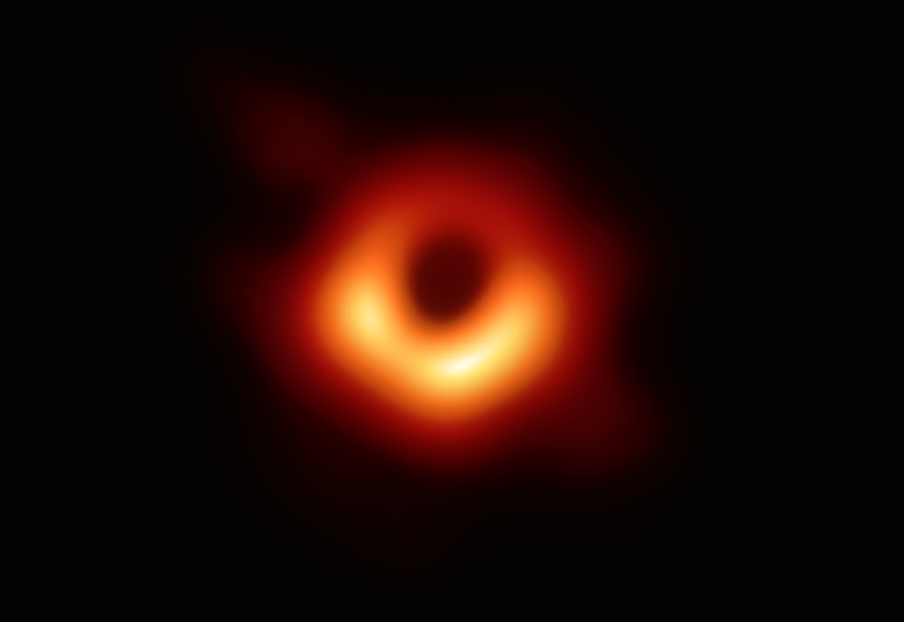Black holes are a front runner for the title of the most mysterious object in our universe. Although predicted by Albert Einstein’s 1915 general theory of relativity and subjected to research for decades, black holes had evaded the gaze of Earth’s most powerful telescopes. On April 10, 2019, the veil was lifted. During a live press conference, the Event Horizon Telescope Collaboration (EHT) and the National Science Foundation (NSF) released the first image of a supermassive black hole located in Messier 87 (M87), a galaxy 55 million light years away.

With regards to the image of M87, it is not a traditional photograph that one imagines when thinking about a camera. Instead, the EHT collaboration utilized and combined the observing power of eight radio telescopes located across the globe. This technique is called very-long baseline interferometry (VLBI), and in principle, it turns an array of radio telescopes into one giant telescope, with a diameter equal to the maximum distance between the telescopes. In the EHT’s case, this was effectively the diameter of the Earth. The telescopes are synced into extreme precision with atomic clocks, and the time delay between the signals received at each telescope are used to reconstruct the image of the source.
Reconstructing this image was no easy task. Even though the EHT had 8 powerful radio telescopes pointing at M87 simultaneously, the EHT collaboration had technological and informational hurdles to jump over. For starters, the sheer amount of data collected totaled over 5 petabytes (PB) worth of data. To put this into context, there are 1024 megabytes (MB) in 1 gigabyte (GB), and 1024 GB in one terabyte (TB), which is a standard amount of default storage space in a modern day computer. A PB is then 1024 GB, so 5 PB is therefore 5 x 1024 = 5120 TB, meaning it would take roughly 5000 modern day average computers to hold this amount of data. In addition to the amount of data, researchers had to overcome severe gaps in the data sampling, which is analogous to reconstructing a jigsaw puzzle with many of its pieces missing. In essence, although VLBI in principle gives researchers one giant telescope with the effective diameter of the Earth, the fact that the telescopes are still separate entities leaves holes in the data. There are only certain points on the sky that researchers can take data from, and thus, can receive only a fraction of the total amount of jigsaw pieces needed to complete the image.
Sorting through and piecing together this data took a combined effort from researchers at MIT’s Computer Science and Artificial Intelligence Laboratory, the Harvard-Smithsonian Center for Astrophysics, and the MIT Haystack Observatory. It was Dr. Katie Bouman, a graduate student at MIT in 2016 and currently a Caltech assistant professor, who led the development of the algorithm that would reconstruct the image of M87’s black hole. Even with many pieces missing to this black hole puzzle, the algorithm can determine whether certain reconstructions make physical sense. In the end, the algorithm produced the now famous image that bolsters our current understanding of general relativity and black holes.
With the advent of M87’s black hole image, it is natural to wonder how many other black holes we can hope to image. The EHT collaboration also attempted to image Sagittarius A* (Sgr A*), the black hole in our own galaxy, yet ran into considerable difficulty due to Sgr A*’s much shorter orbital period, which leads to rapid fluctuations in its signal on short timescales. Additionally, many cosmic objects lie within our line of sight to Sgr A* including stars, planets, and dust, thus further complicating the matter. Regardless, the M87 image has already provided us with new insight on the properties of supermassive black holes, and despite their inherent invisible nature, the future of our understanding of them looks very bright.
Post by Kyle Kabasares, graduate student working on his PhD in Astrophysics at UCI.